|
BENAKEION ARCHAEOLOGICAL MUSEUM OF KALAMATA
6 Papazoglou St, tel. 27210 63100
Open daily (except Monday) 8:00-14:30
Entrance 2 euro Located on the corner of Benaki and Papazoglou streets, the museum is housed at a mid-19th century building that was donated to the Archaeological Service by Antonis Benakis, the founder of the Benaki Museum in Athens. It was first opened in 1971, but an earthquake that struck the city in 1986 devastated the museum. Refurbishment work and studies conducted for the reorganization of exhibits lasted until 1995, when the museum reopened with a ground-floor exhibition. 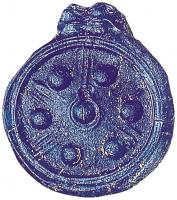 Amulet of blue glass (vaulted grave of Dara) Work on the upper level was completed three years later. Renovation work has already begun on the Palia Agora building (Aghion Apostolon square), where it will be housed the new Archaeological Museum of Messinia. Second floor
The second floor presents finds ranging from Messinia’s prehistoric and early historic years. The exhibition begins at Room 1 and is comprised of finds from Nichoria, west of Kalamata, where a settlement dated between the mid-Hellenic era (2000 BC) and the Byzantine era (13th century AD) was excavated. Items here include ceramic and copper finds from a vaulted Mycenaean tomb, a 5th century BC lecythus, or oilflask, as well as jewelry from both the tomb and settlement. Room 2 features finds such as broken vase pieces, whole vases and stone tools ranging from the Mycenaean and Protogeometric periods that were excavated at the Nichoria settlement. Also exhibited here are finds from tombs at the villages of Karpofora and Rizomylo (late17th century-13th century BC) as well as the Vathyrema location. 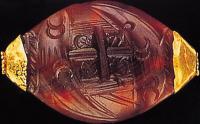 Talismanic
seal with gold
clasp (vaulted
grave of
Nichoria) Room 3 is devoted to the prehistoric acropolis of Malthi, close to the village Vassiliko in the northern Messinia. Activity in Malthi peaked between 2000 and 1600 BC (mid-Hellenic and Mycenaean eras). Also exhibited in the same room is a seal from a mansion excavated in Akovotika. It dates back to the early Hellenic era. Room 4 presents more recent finds from various parts of the Messinia region, including Psari, Chalkia, Diodia, Aristomeni, Raches, the ancient settlements of Kopanaki, Akovitika, and a Mycenaean cemetery at Ellinika, in the Anthia region. The exhibition also includes finds that were accidentally discovered by individuals and passed on to the museum. Ceramic works and urns are exhibited in the upper-level’s foyer and staircase. Ground Level
In Room 1, the visitor will find heads of Roman-era statues, a Hera Borghese-type headless statue from Kyparissia, a marble statue of a female body from Petalidi (ancient Koroni) and an inscripted marble pillar from ancient Messini in the 2nd century AD. Room 2 focuses on burial rituals, while Room 3 features two marble bases of sprinklers, a marble slate with three cavities that were used as measuring units, an engraved limestone pillar from ancient Thouria, a statue’s base adorned with inscriptions (from ancient Koroni) and four capitals, three Ionian, and one Doric. On show in the final room are parts of mosaic floors from Roman-era houses as well as the head of a marble statue of Apollo from Kyparissia. 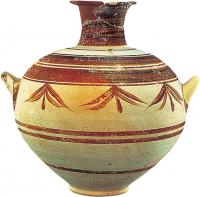 Spherical
amphora
(Aristomenes) HISTORY AND FOLKLORE MUSEUM OF KALAMATA
12 Aghiou Ioannou St & Kyriakou St, tel. 27210 28449
Open Tuesday to Saturday 9:00-13:00, Sunday 10.00-13.00
Closed on Monday.
Entrance 2 euros. 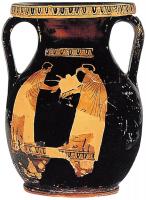 Red-figure
vase
(Nichoria-
Karpofora) The museum was founded by a local academic society with the objective of gathering archive material and objects concerning the Greek War of Independence in 1821, as well as preserving and exhibiting more recent items from the wider region. It first opened in 1973 at the Kyriakou Mansion, a traditional, early 19th century building. It re-opened in 2002 (since the building was devastated by the 1985 earthquake). Besides information on the region, the society that founded the museum and the Kyriakou family, visitors can also find small thematic sections concerning the area’s agricultural and pastoral life, farming, weaving techniques, pottery, and urban professions – all in the museum’s ground level. Another series of exhibits here is focused on the daily life of citizens. Overall, the ground-level exhibitions offer the visitor a thorough picture of pre-industrial life in Messinia. 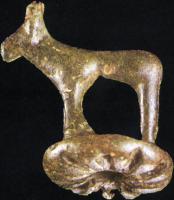 Bronze seal with zoomorphic
handle (Nichoria At the upper level, the exhibition begins with an impressive thematic show on printing and bookbinding. It reminds the visitor that the first printing facility that operated in liberated Greece was located in Kalamata. Major pre-revolution literature headed for Europe was printed here. The first room to the right depicts a typical urban home in Kalamata during the early 20th century. The traditional cafe, or “kafeneio”, is recreated in this level’s hall. The large room to the right offers a presentation of historic material concerning the Greek revolution of 1821. Items, all regional, include personal belongings, weapons, and traditional costumes. The G. Karelias Room focuses on the theme of traditional dress. A small room at the first floor’s rear features post-Byzantine religious art from the region.
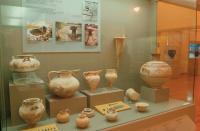 Anthia-Ellinika
(Finds from Mycenean necropolis) KALAMATA MILITARY MUSEUM
10 Mitropolitou Meletiou St., tel. 27210 21219
Open Tuesday-Saturday 9:00-14:00, Wednesday 18:00-20:00,
Sunday 11:00-14:00. Closed on Mondays.
Free entrance. This museum was launched in June, 2006, and is housed at a building offered by the Greek Orthodox Church in the region. Its objective is to present modern Greek history, from the 1821 revolution until present times through various texts and photographic and audio-visual material. 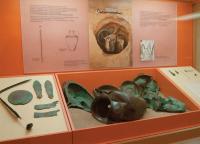 Vaulted grave of Nichoria A visit to the museum begins with an exhibition of costumes and other material concerning the 1821 uprising. A section on the Greek Macedonian Struggle follows. Next, the visitor will find an exhibition on the Balkan Wars. A large part of exhibition is focused on the Asia Minor Catastrophe. Sections on World War I and II follow, with material related to the Battle of Crete, the Middle East and the national resistance. Also included here are mentions of Greek peace missions in Korea, Somalia, the former Yugoslavia, the Gulf War and Afghanistan.  Skyphos (Nichoria-Karpofora) The museum’s “Sound and Light” room offers projections of a film on the history of the 9th Infantry Regiment. Visitors can view a book accumulating the names of war casualties from the Messinia region between 1897 and 1974. On display at the museum’s surrounding grounds is an M48-A5 tank, an M8 tank, various arms, and an F -5 fighter plane. 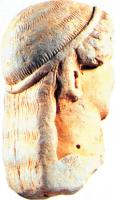 Archaic
marble head
of Apollo
(Kyparissia) Municipal Cultural Center of Kalamata
33 Aristomenous St., tel. 27210 22607
Open Monday to Friday 18:00-20:00
Free entrance. The art gallery was founded in 1962 following the initiatives taken by the Kalamata Popular Library and the artist Costas Yannoukopoulos, aka C. Yannako. Over 100 works are on display at specially designed sections of the Municipal Cultural Center. The gallery’s collection, which exceeds 430 works, is comprised of paintings, drafts, engravings, constructions, and sculptures by significant Greek artists of the 20th century, as well as works by local artists. The collection mainly consists of works dated between 1950 and 1960. The gallery intends to keep adding to its collection with the ultimate aim of offering a complete panorama of Greek art in the 20th century. Works by artists such as Spyros Vikatos, Giorgos Roilos, Vassilis Germenis, Epaminondas Thomopoulos, Giorgos Kosmadopoulos, Theodore Lazaris and Thalia Flora-Karavia indicate how strongly Greek artists were influenced by western trends, especially Impressionism, early in the 20th century. 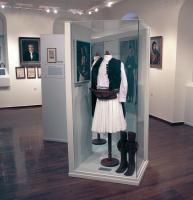 Historical material concerning the 1821 Greek War
of Independence Forays into abstract art, which essentially began here in the late 1950s, are depicted in works by artists such as Christos Lefakis, and Yannis Maltezos. A certain “Greekness”, expressed by the fusion of timeless elements of Greek civilization and European art trends, is represented in works by Giorgos Gounaropoulos, Spyros Vasileiou, Nikos Hatzikyriakos-Gikas, Nikos Eggonopoulos, Yiannis Tsarouchis and other significant inter-war artists. The ’60s generation, which became closely attached to the international art circuit and projected Greek art abroad, is represented through works by the likes of Thanos Tsingos, Christos Karas, Nikos Kessanlis, Damianos Kontos and Costas Tsoklis. Around the same time, experiments into descriptive art are depicted in the works of artists such as Yiannis Gaitis, Vassilis Sperantzas, Dimitris Mytaras and Alekos Fasianos. The course of modern Greek engravings can be detected in works by Dimitris Galanis, Angelos Theodoropoulos, Efthimios Papadimitriou, Giorgos Velissaridis, Costas Grammatopoulos, Takis Katsoulidis and Aria Komianou. The Kalamata gallery’s collection also includes a small number of sculptures by Christos Kapralos, Costas Klouvatos, Lazaros Lameras, Giorgos Zoggolopoulos, Giorgos Lappas, and a draft by Giannoulis Halepas.  Exhibit
of the daily
life in the area Recent additions to the gallery’s collection include works by Michalis Katzourakis, Yiannis Bouteas and Alekos Fasianos. The gallery’s new acquisitions include a 56-piece donation by Dafni Kostopoulou, as well as a 10-piece donation from Annie Kostopoulou which includes works by Nikos Alexiou, Yiannis Valavanidis, Yiannis Gaitis, Iason Molfesis, Kyriakos Mortarakos, Tasos Pavlopoulos, Spyros Politis, Thanassis Totsikas and Yiannis Psychopaidis. These cover a wide range of styles that emerged from the ’70s onwards. 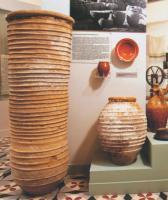 Exhibit
of the daily
life in the area «A. TASSOS» MUNICIPAL GALLERY OF KALAMATA
5 Papazoglou St, tel. 27210 88991
Open Tuesday and Thursday 15:00-21.00, Wednesday and Friday 9:00-14:00,
Saturday 9:00-15:00. Closed on Mondays
Free entrance The gallery belongs to the Municipal Organization for Cultural Development in Kalamata. It has been housed at a restored neoclassical building in the city center since 2002. It was named after A. Tassos, who hailed from Messinia, following the donation of a considerable number of engravings from his collection. This art center reflects artistic trends in painting, sculpture, pottery and engravings of the 80s. Its collection includes works by Chronis Botsoglou, Panayiotis Tetsis, Takis Katsoulidis, Yiannis Psychopaidis, Costas Varotsos and Michalis Katzourakis. 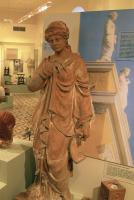 View of the ground floor A collection of some 350 works, which reflect various artistic trends, was offered to the gallery by Greek artists following a devastating earthquake that struck Kalamata in 1986. Periodical exhibitions, organized by the gallery, and, occasionally, in association with various cultural agencies, are extremely interesting. Covering all the artistic fields, the shows range from the classical to the avan-garde. 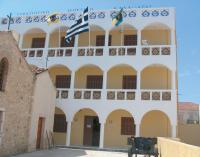 Military Museum of Kalamata POPULAR LIBRARY OF KALAMATA
Municipal Cultural Center of Kalamata
33 Aristomenous St (5th floor), tel: 27210 22607, www.laiki-lib-kal.gr
Summer season: Monday, Tuesday, Thursday 8:30-13:30 and 17:30-20:30
Winter season: Monday to Friday 9:00-13:00 and 16:00-20:00
Free entrance Founded in 1933 by 46 intellectuals, the library ranks as one of Greece’s biggest provincial libraries. Its development in various cultural fields remains continuous to this very day. The Athens Academy has granted the library its first prize. It possesses a study room for 50 persons, natural lighting facilities, airconditioning, as well as open-air reading space. Activities have included the publication of three titles on Messinian literature. The library’s collection numbers over 85,000 books, 2,500 magazine titles (60,000 issues in total) and 200 regional newspapers (over 100,000 issues), 42 of which date back to the 19th century. Also available here are 450 binded editions covering major Messinian newspapers from 1935 to today. The library also carries more than 50,000 copies of non-Messenian newspapers, mostly from the pre-war period, archives concerning World War II and the 19th century, as well as private and public manuscripts. Rare and priceless books, and relics from the 16th and 17th centuries, are included in the library’s collection. The library recently acquired a considerable number of book titles from various Kalamata citizens. There has been much emphasis on computerizing the library in recent years. Modernization efforts have included work on establishing a website. The library receives fundamental and multifaceted support from the Alpha Bank Group, the I.F. Kostopoulos Foundation, the Holy Metropolis of Messinia and the Kalamata Municipality. KALAMATA MUNICIPAL CENTRAL LIBRARY
Ypapanti square, tel 27210 96818, www.infolibraries.gr/kalamata.
Open daily 8:30-14:30.
Free entrance. A newly-established library, it was launched in October 2004 with the objective of pursuing educational, cultural and informational concerns. The library already possesses approximately 7,400 books whose fields include medicine, psychology, children’s literature, social studies and computer studies. Also available here are encyclopedias, dictionaries, as well as titles on art and religion. The library is equipped with a mobile unit that pays visits to schools, especially in remote areas surrounding Kalamata, with the aim of lending books, audio-visual material and other possessions. A Municipal Information Center will soon start operating at the library.
|